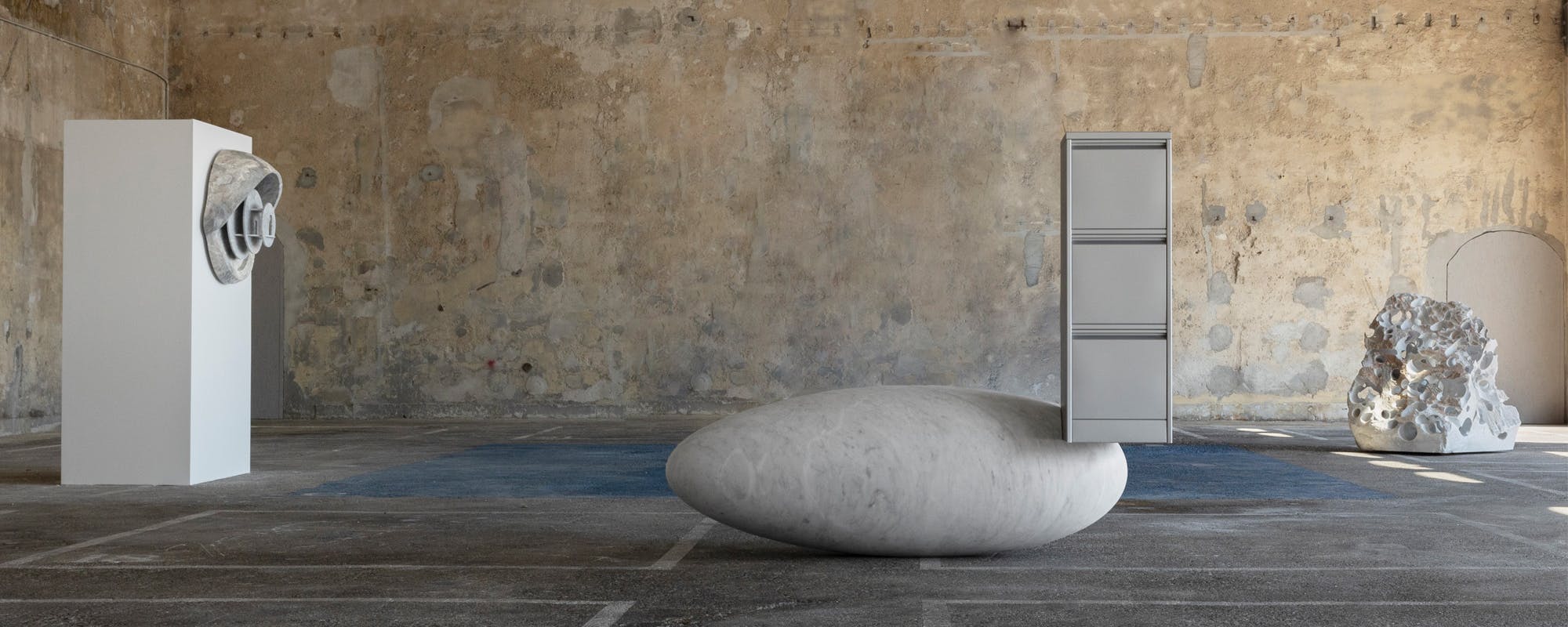between technology and figuration in sculpture
The works by Olivia Erlanger, Nicola Martini and Tarik Kiswanson – winners of the sixth Henraux International Sculpture Prize – have been unveiled
Act III (Spellbound) by Olivia Erlanger, Omag Tower 7 CNC by Nicola Martini and Reconciliation by Tarik Kiswanson are the three new marble works that have become part of the important sculpture collection of the Henraux Foundation. Created by the winning artists of the 6th edition of the Henraux International Sculpture Prize, for each of the artists these works constitute the very first time they have worked with marble. As stated in the catalog essay by Edoardo Bonaspetti, Artistic Director of the Henraux Foundation, the designs were selected for their originality and for the fascinating, varied ways in which they tap the potential of this material.
As the Foundation's most high-profile activity, the International Sculpture Prize is a cultural project that represents, more than any other, the continuity of the history of Henraux in the Versilia area and in the Apuan Alps, and also of marble itself. Moreover, it references the great revolution in contemporary sculpture that the company triggered in the 1960s. The participation of leading national and international artists, with the involvement of pre-eminent figures in the global contemporary art world, is the Henraux Prize's contribution to contemporary sculpture in marble.
Paolo Carli, President of Henraux SpA and the Henraux Foundation, underlines how over these years the interactions between technology and figuration have given rise to a constantly evolving scene. The processes of working marble using computer numerical control are a part of that scene and have helped to shape new thinking and new organizations. The Henraux Prize is concerned with the relationship between technology and figuration, and also with the expressive research that is geared towards addressing the changes under way, thanks also to the state-of-the-art systems that the company will make available to the artists.
Olivia Erlanger (USA, 1990, lives and work in New York) explores the way in which environments and objects influence our identity and perceptions. Her visual language is disturbing and visionary in its capacity to manipulate reality. For the prize, Erlanger created her first marble work, Act IlI (Spellbound), focusing on the series of “eye-sculptures” (2022-ongoing), the irises of which represent mental spaces. In particular, the work explores memory and the “threshold effect,” a psychological phenomenon that connotes the loss of short-term memory upon the shift from one place to another: a series of open doors forms a corridor that then composes the image of a dilated pupil, reminding us that our experience in time and space is marked by the environments in which we live. Memory is a malleable material, and the artist turned to marble for its permanent qualities, as if to counterbalance the transitory nature of life.
Tarik Kiswanson (Sweden, 1996, lives and works in Paris) was born into a family of exiled Palestinians. In his works, shapes and perceptions are permeated by sensations of instability and transformation, connected not only to his identity as a second-generation migrant, but also to historic and existential dimensions of rupture and loss. His research concentrates on the interstitial and transitory states of the human condition, exploring themes such as identity, metamorphosis and renewal. His sculpture, entitled Reconciliation, is in turn a transformation of a previous work, The Wait (2023), and takes the form of a marble chrysalis or cocoon onto which a filing cabinet from an immigration office has been grafted. These two elements are fused into a state of instability and levitation, where the cocoon symbolizes birth and becoming, while the cabinet, interpretable both in the individual and collective senses, evokes the dynamics of assimilation into society. The tension between genesis and transition, life and death, is central to Kiswanson’s work, and the collision between these two bodies––which apparently belong to worlds very distant from each other––unleashes a primitive generative force that reveals unexpected possibilities and new horizons.
The work of Nicola Martini (Italy, 1984, lives and works in Milan), is entitled Omag Tower 7 CNC, just like one of Henraux’s pieces of computer numerical control (CNC) machinery. The machine’s robotic arms travel along seven axes, and are used mostly to mill and remove marble. The process of subtraction is central to an understanding of a work that focuses attention on the relationships between the individual, the artefact and nature. Martini selected a shapeless, residual block from the Cervaiole quarry on Mount Altissimo, perforating it in every direction, right up to the limit of its mechanical resistance. Removing material from a block is the action that is required to create a sculpture, but at the same time it also means removing material from the mountain to which that block belongs. The artist invites us to move beyond the dialectical systems that place subject and object in opposition, encouraging instead a non-anthropocentric and non-hierarchical vision. To concentrate on the void is to overturn perspectives, highlighting the qualities and processes through which the material itself is created, with a view to establishing a connection between human memory and the millennial memory of nature.
The jury––composed of Edoardo Bonaspetti, Artistic Director of the Henraux Foundation; Eike Schmidt, director of the Museo di Capodimonte, Naples; Eva Fabbris, director of the Museo Madre, Naples; Nicola Ricciardi, artistic director of miart, the Milan International Contemporary Art Fair; and Chiara Costa, head of programs at the Prada Foundation, Milan––awarded the 2024 Henraux Prize following a careful selection, by the selection committee, of the designs and the artists submitted for consideration. The members of the selection coommittee are Carina Bukuts and Liberty Adrien, curators of Portikus in Frankfurt; Nadim Samman, curator of the KW Institute for Contemporary Art in Berlin; Ilaria Marotta and Andrea Baccin, founders and directors of CURA Magazine and the Centro d’Arte Contemporanea Art Basement in Rome; Alessandro Rabottini, curator and artistic director of the Fondazione In Between Art Film, Rome; and Ilaria Bonacossa, director of the Palazzo Ducale in Genoa.
